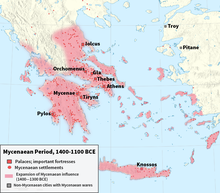
Back Miceense Griekeland Afrikaans Mykenische Kultur ALS يونان الموكيانية Arabic حضاره ميكينيه ARZ Civilización micénica AST Mikena sivilizasiyası Azerbaijani میسن مدنیتی AZB Мікенская цывілізацыя Byelorussian Микенска цивилизация Bulgarian মাইসিনীয় গ্রিস Bengali/Bangla
 | |
| Alternative names | Mycenaean civilization |
|---|---|
| Geographical range | Mainland Greece, Aegean islands and Western Anatolia |
| Period | Bronze Age |
| Dates | c. 1750 – c. 1050 BC |
| Type site | Mycenae |
| Major sites | Pylos, Tiryns, Midea, Orchomenos, Iolcos |
| Characteristics |
|
| Preceded by | Minoan civilization, Korakou culture, Tiryns culture |
| Followed by | Greek Dark Ages |
| History of Greece |
|---|
 |
|
|
Mycenaean Greece (or the Mycenaean civilization) was the last phase of the Bronze Age in ancient Greece, spanning the period from approximately 1750 to 1050 BC.[1] It represents the first advanced and distinctively Greek civilization in mainland Greece with its palatial states, urban organization, works of art, and writing system.[2][3] The Mycenaeans were mainland Greek peoples who were likely stimulated by their contact with insular Minoan Crete and other Mediterranean cultures to develop a more sophisticated sociopolitical culture of their own.[4] The most prominent site was Mycenae, after which the culture of this era is named. Other centers of power that emerged included Pylos, Tiryns, and Midea in the Peloponnese, Orchomenos, Thebes, and Athens in Central Greece, and Iolcos in Thessaly. Mycenaean settlements also appeared in Epirus,[5] Macedonia,[6] on islands in the Aegean Sea,[7] on the south-west coast of Asia Minor, [7] and on Cyprus,[8] while Mycenaean-influenced settlements appeared in the Levant[9] and Italy.[10]
The Mycenaean Greeks introduced several innovations in the fields of engineering, architecture and military infrastructure, while trade over vast areas of the Mediterranean was essential for the Mycenaean economy. Their syllabic script, Linear B, offers the first written records of the Greek language, and their religion already included several deities that can also be found in the Olympic pantheon. Mycenaean Greece was dominated by a warrior elite society and consisted of a network of palace-centered states that developed rigid hierarchical, political, social, and economic systems. At the head of this society was the king, known as a wanax.
Mycenaean Greece perished with the collapse of Bronze Age culture in the eastern Mediterranean, to be followed by the Greek Dark Ages, a recordless transitional period leading to Archaic Greece where significant shifts occurred from palace-centralized to decentralized forms of socio-economic organization (including the extensive use of iron).[11] Various theories have been proposed for the end of this civilization, among them the Dorian invasion or activities connected to the "Sea Peoples". Additional theories such as natural disasters and climatic changes have also been suggested. The Mycenaean period became the historical setting of much ancient Greek literature and mythology, including the Trojan Epic Cycle.[12]
- ^ Knodell 2021, Table 1, pp. 7, 65.
- ^ Lazaridis et al. 2017, Supplementary Information: pp. 2–3
- ^ Fields 2004, pp. 10–11.
- ^ "Mycenaean Civilization". World History Encyclopedia. Retrieved 29 July 2021.
- ^ Hammond 1976, p. 139: "Moreover, in this area a small tholos-tomb with Mycenaean pottery of III B style and a Mycenaean acropolis have been reported at Kiperi near Parga, and another Mycenaean acropolis lay above the Oracle of the Dead on the hill called Xylokastro"; Tandy 2001, p. xii (Fig. 1); p. 2: "The strongest evidence for Mycenaean presence in Epirus is found in the coastal zone of the lower Acheron River, which in antiquity emptied into a bay on the Ionian coast known from ancient sources as Glykys Limin (Figure 2-A)."
- ^ Hatzopoulos 2011, p. 53: "There is one illusion that ought to be first dispelled—that Mt Olympus and the Kambounian mountains constituted an impassable barrier between Thessaly and Macedonia. In fact recent archaeological discoveries have established that already in the second millennium bc the Mycenaean world extended well beyond Thessaly and included at least the southern part of Macedonia. Abundant Mycenaean pottery, both imported and locally produced, weapons, pins, brooches and syllabic script have been found in tombs of Orestis, Elimeia and Pieria"; Borza 1992, p. 64: "The existence of a Late Bronze Age Mycenaean settlement in the Petra not only confirms its importance as a route from an early period, but also extends the limits of Mycenaean settlement to the Macedonian frontier."
- ^ a b Castleden 2005, p. 192.
- ^ van Wijngaarden 2002, Part III: Cyprus, pp. 125–202.
- ^ van Wijngaarden 2002, Part II: The Levant, pp. 31–124; Bietak & Czerny 2007, Sigrid Deger-Jalkotzy, "Mycenaeans and Philistines in the Levant", pp. 501–629.
- ^ Peruzzi 1980; van Wijngaarden 2002, Part IV: The Central Mediterranean, pp. 203–260.
- ^ Morris 1996, "Greece: Dark Age Greece", pp. 253–256.
- ^ The extent to which Homer attempted to or succeeded in recreating a "Mycenaean" setting is examined in Moses I. Finley, The World of Odysseus, 1954.